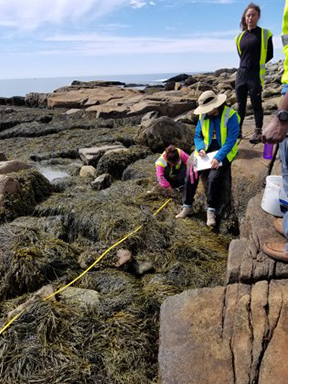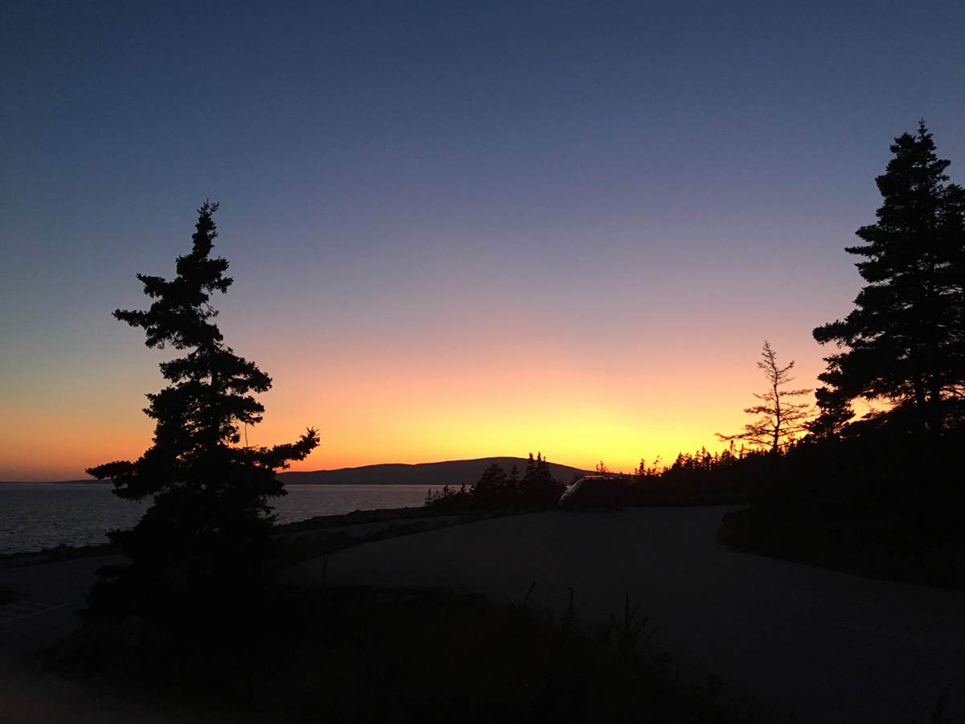.
Salt, Water, and Science—A 10-Day Adventure in Acadia
By Masooma Hasnain, Ignite Fellow 2019
Ecosystems are typically able to regulate themselves as they experience change. However, due to human activity, the climate is changing too quickly for species to evolve and adapt. Through the Ignite Fellowship, I worked with marine biologist Dr. John Cigliano to take part in a two-week study at the stunning Acadia National Park. Dr. Cigliano and my team of other high school students from the “concrete jungle” of Southern California researched the effects of a changing climate on intertidal zone species on Maine’s coastland, which has not been the focus of many studies.
 Intertidal zones are typically made up of subzones species like splash zone algae, barnacles, and seaweed because they are closest to the water. Outdoor fieldwork is at the mercy of the weather, unlike many experiments we have done at school. If there were no thunderstorms, we would go to different sites during low tide. Once at the sites, we took note of the different species present at different quadrat locations. Quadrats are frames that are used to collect the random distribution of species over a given area or the changes in composition of species in a set location. Dr. Cigliano’s methodology used the latter purpose. Our research team was the sixth group to work on the study this year and that taught me the importance of patience.
Intertidal zones are typically made up of subzones species like splash zone algae, barnacles, and seaweed because they are closest to the water. Outdoor fieldwork is at the mercy of the weather, unlike many experiments we have done at school. If there were no thunderstorms, we would go to different sites during low tide. Once at the sites, we took note of the different species present at different quadrat locations. Quadrats are frames that are used to collect the random distribution of species over a given area or the changes in composition of species in a set location. Dr. Cigliano’s methodology used the latter purpose. Our research team was the sixth group to work on the study this year and that taught me the importance of patience.
Fieldwork can sometimes be repetitive and dull, and that makes it important to have passion in your research as you can spend hours on your knees measuring seaweed. It also helps to have a friendly team. Even though our group of eight high schoolers did not meet prior to the expedition, we got along well. Some people bonded over their love of horror movies, others over their love of Mario Kart. I admit I was one of the latter. When the tides were high and we finished our work in the lab, my Ignite team broke out card games or asked for a third buddy (we were allowed to venture around our bunkhouse as long as we had three people) to go on a hike. One of my favorite memories from Acadia was a small hike we did to a vantage point of the Atlantic Ocean. We didn’t have to talk to enjoy the moment, instead, we absorbed the peaceful sounds of waves crashing beneath our feet.
In addition to gathering data for Dr. Cigliano’s study, we created our own mini-experiment to practice our lab skills. As a group, we decided to determine if ocean acidification and warming had an effect on the response times of Littorina littorea (common periwinkle). After filling up four coolers with “instant ocean” (a mix of salts and minerals) and 15 gallons of water, we decided to have one cooler with the worst-case scenario for ocean acidification (7.7 pH), one cooler with the worst scenario for ocean warming (18°C), one cooler with both worst-case scenarios (7.7 pH and 18°C), and one cooler as the control (13°C and 8.3 pH). To ensure the coolers’ pH and temperature would remain stable, a CO2 tank and pH probe were hooked up to the coolers to lower the pH and a cooler cycled the water of each cooler.
.


.
While the “oceans” stabilized, we collected approximately 100 common periwinkles and six green crabs near our quadrat sites. The snails and crabs were split between the four coolers and kept separately in plastic boxes that were covered in holes. The snails were in treatment for approximately 43 hours before the first trial to acclimate. In order to measure the response time of snails, we created alarm cues by adding a single green crab to the 200mL of the control cooler’s solution for one hour. Snails have already been observed to move out from the water if they are exposed to an alarm cue such as crab saturated waters. For the first trial, 200 mL of the respective treatment water was placed into 1 L beaker. Three snails were placed at the bottom of the beaker. After 10 minutes, 20 mL of the alarm cue was poured into the center of the beaker. The position of each snail (bottom, side, breaking/out of water) was recorded every minute for 30 minutes.
After the first trial, we observed that the snails didn’t have a drastic difference in their movement, even after the alarm cue was added. Also, if a snail broke the surface of the water before the alarm cue was added, its data was not recorded. For the following trials, the crab was left in the treatment for one hour and the snails’ positions were recorded for an hour. The positions were recorded every three minutes and the sample size of the snails were increased from three to five. The revised procedure was repeated three times and there was not a valid conclusion. The experiment would need to be repeated with a much larger sample size and with more trials for greater accuracy and validity. However, the experiment was good practice of an animal behavior lab and is another example of how ecology does not run on human time. Unlike other subjects, human presence can affect the behavior of animals. While the snails are being watched for an hour, it is important to not make unnecessary movement as the snails may be responding to the movement of people rather than the alarm cue. Although we didn’t discover groundbreaking research, perhaps one day we can use the skills we learned during our snails lab in a research study. (Note: all crabs and snails were released at the end of the experiment.)
.

.
During our last few days in Acadia, Dr. Cigliano left the expedition to attend a conference. This led to a unique experience as our group had the opportunity to work with another scientist—Hannah Webber, Marine Ecology Director of Schoodic Institute—and her research on the effects of harvesting seaweed, specifically Ascophyllum nodosum, to which she lovingly called “Asco.” With the help of several Schoodic interns, we continued her research and specifically measured the weight, height, and distance between air bladders of “Asco” at 6 a.m. While I don’t think I have developed a passion for seaweed, I loved learning about the different methods of field research. The scientists were open to questions and we even learned about a completed study about microplastics from a scientist who presented her findings while in Acadia. After that lecture and every drink of water, my teammates and I were telling each other that we had probably ingested microplastics. Even though we joked around, the detrimental effect of human activities in our oceans remains on our minds.
The research we did in Maine is just one step to understanding what is happening in our oceans and what we can do to provide solutions to protect beautiful places such as Acadia National Park. I will definitely treasure the memories I made while in Acadia with my Ignite team.
.
To apply to this fellowship, visit our website: Ignite LA Student Science Awards.
.
Sign up for the Earthwatch Newsletter
Be the first to know about new expeditions, stories from the field, and exciting Earthwatch news.